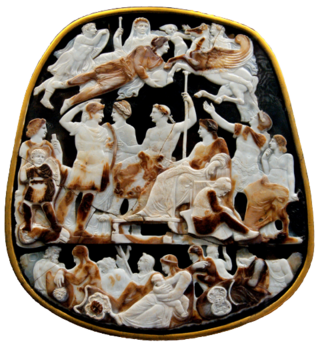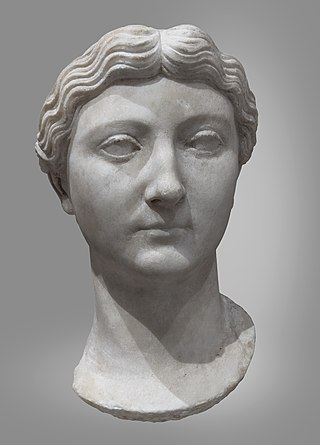Births
| | This section is empty. You can help by adding to it. (November 2023) |
| Millennium: | 1st millennium BC |
|---|---|
| Centuries: | |
| Decades: | |
| Years: |
| 33 BC by topic |
| Politics |
|---|
| Categories |
Year 33 BC was either a common year starting on Saturday, Sunday or Monday or a leap year starting on Sunday (link will display the full calendar) of the Julian calendar (the sources differ, see leap year error for further information) and a leap year starting on Saturday of the Proleptic Julian calendar. At the time, it was known as the Year of the Consulship of Octavian and Tullus (or, less frequently, year 721 Ab urbe condita ). The denomination 33 BC for this year has been used since the early medieval period, when the Anno Domini calendar era became the prevalent method in Europe for naming years.
| | This section is empty. You can help by adding to it. (November 2023) |

The Julio-Claudian dynasty comprised the first five Roman emperors: Augustus, Tiberius, Caligula, Claudius, and Nero.

Around the start of the Common Era, the family trees of the gens Julia and the gens Claudia became intertwined into the Julio-Claudian family tree as a result of marriages and adoptions.

Year 27 BC was either a common year starting on Sunday, Monday or Tuesday or a leap year starting on Monday of the Julian calendar and a common year starting on Sunday of the Proleptic Julian calendar. At the time, it was known as the Year of the Second Consulship of Octavian and Agrippa. The denomination 27 BC for this year has been used since the early medieval period, when the Anno Domini calendar era became the prevalent method in Europe for naming years.
Year 12 BC was either a common year starting on Saturday, Sunday or Monday or a leap year starting on Sunday of the Julian calendar and a common year starting on Friday of the Proleptic Julian calendar. At the time, it was known as the Year of the Consulship of Messalla and Quirinius. The denomination 12 BC for this year has been used since the early medieval period, when the Anno Domini calendar era became the prevalent method in Europe for naming years.
This article concerns the period 39 BC – 30 BC.
AD 8 was a leap year starting on Sunday of the Julian calendar. In the Roman Empire, it was known as the Year of the Consulship of Camillus and Quinctilianus. The denomination "AD 8" for this year has been used since the early medieval period, when the Anno Domini calendar era became the prevalent method in Europe for naming years.
The 0s BC were the period between 9 BC and 1 BC, the last nine years of the before Christ era. It is one of two "0-to-9" decade-like timespans that contain nine years, along with the 0s.
Year 14 BC was either a common year starting on Thursday or Friday or a leap year starting on Wednesday, Thursday or Friday of the Julian calendar and a common year starting on Tuesday of the Proleptic Julian calendar. At the time, it was known as the Year of the Consulship of Crassus and Lentulus. The denomination 14 BC for this year has been used since the early medieval period, when the Anno Domini calendar era became the prevalent method in Europe for naming years.
Year 40 BC was either a common year starting on Thursday, Friday or Saturday or a leap year starting on Thursday or Friday of the Julian calendar and a common year starting on Friday of the Proleptic Julian calendar. At the time, it was known as the Year of the Consulship of Calvinus and Pollio. The denomination 40 BC for this year has been used since the early medieval period, when the Anno Domini calendar era became the prevalent method in Europe for naming years.

Year 1 BC was a common year starting on Friday or Saturday in the Julian calendar and a leap year starting on Thursday in the proleptic Julian calendar. It was also a leap year starting on Saturday in the Proleptic Gregorian calendar. At the time, it was known as the Year of the Consulship of Lentulus and Piso. The denomination 1 BC for this year has been used since the early medieval period when the Anno Domini calendar era became the prevalent method in Europe for naming years. The following year is AD 1 in the widely used Julian calendar, which does not have a "year zero".
Year 6 BC was a common year starting on Sunday or Monday of the Julian calendar and a common year starting on Friday of the Proleptic Julian calendar. At the time, it was known as the Year of the Consulship of Balbus and Vetus. The denomination 6 BC for this year has been used since the early medieval period, when the Anno Domini calendar era became the prevalent method in Europe for naming years.
Year 7 BC was a common year starting on Saturday or Sunday of the Julian calendar and a common year starting on Thursday of the Proleptic Julian calendar. In the Roman world, it was known as the Year of the Consulship of Nero and Piso. The denomination 7 BC for this year has been used since the early medieval period, when the Anno Domini calendar era became the prevalent method in Europe for naming years.
Year 9 BC was either a common year starting on Wednesday, Thursday or Friday or a leap year starting on Thursday of the Julian calendar and a leap year starting on Monday of the Proleptic Julian calendar. At the time, it was known as the Year of the Consulship of Drusus and Crispinus. The denomination 9 BC for this year has been used since the early medieval period, when the Anno Domini calendar era became the prevalent method in Europe for naming years.

Year 11 BC was either a common year starting on Monday or Tuesday or a leap year starting on Sunday, Monday or Tuesday of the Julian calendar and a common year starting on Saturday of the Proleptic Julian calendar. At the time, it was known as the Year of the Consulship of Tubero and Maximus. The denomination 11 BC for this year has been used since the early medieval period, when the Anno Domini calendar era became the prevalent method in Europe for naming years.
Year 13 BC was either a common year starting on Friday, Saturday or Sunday or a leap year starting on Friday or Saturday of the Julian calendar and a leap year starting on Wednesday of the Proleptic Julian calendar. At the time, it was known as the Year of the Consulship of Nero and Varus. The denomination 13 BC for this year has been used since the early medieval period, when the Anno Domini calendar era became the prevalent method in Europe for naming years.
Year 38 BC was either a common year starting on Sunday or Monday or a leap year starting on Saturday, Sunday or Monday of the Julian calendar and a common year starting on Sunday of the Proleptic Julian calendar. At the time, it was known as the Year of the Consulship of Pulcher and Flaccus. The denomination 38 BC for this year has been used since the early medieval period, when the Anno Domini calendar era became the prevalent method in Europe for naming years. It was also the first year of the Spanish era calendar in use in Hispania until the 15th century.
Year 15 BC was either a common year starting on Tuesday, Wednesday or Thursday or a leap year starting on Wednesday of the Julian calendar and a common year starting on Monday of the Proleptic Julian calendar. At the time, it was known as the Year of the Consulship of Drusus and Piso. The denomination 15 BC for this year has been used since the early medieval period, when the Anno Domini calendar era became the prevalent method in Europe for naming years.

Nero Claudius Drusus Germanicus, also called Drusus the Elder, was a Roman politician and military commander. He was a patrician Claudian on his birth father's side but his maternal grandmother was from a plebeian family. He was the son of Livia Drusilla and the legal stepson of her second husband, the Emperor Augustus. He was also brother of the Emperor Tiberius, father to both the Emperor Claudius and general Germanicus, paternal grandfather of the Emperor Caligula, and maternal great-grandfather of the Emperor Nero.

Livia Drusilla was Roman empress from 27 BC to AD 14 as the wife of emperor Augustus. She was known as Julia Augusta after her formal adoption into the Julian family in AD 14.
Tiberius Claudius Nero was a Roman politician, senator, and praetor who lived in the last century of the Roman Republic.